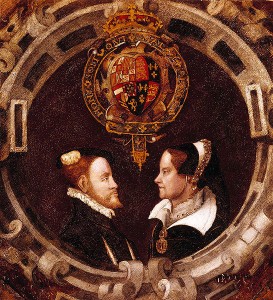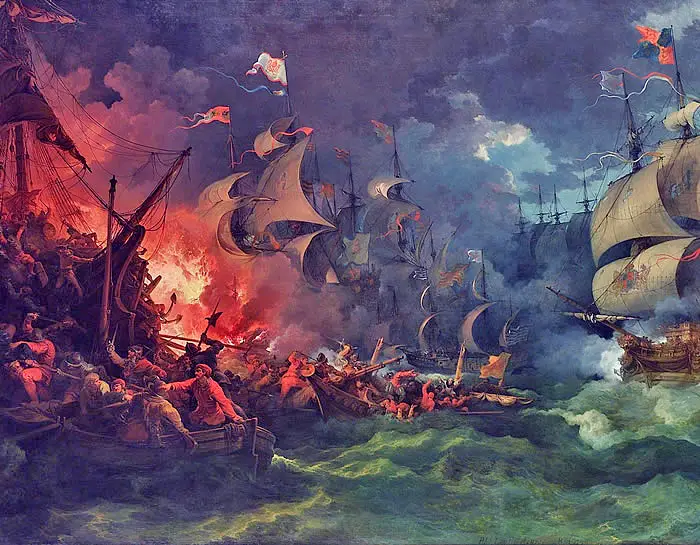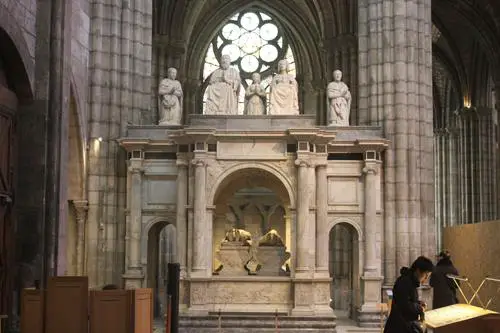
Philip and Mary I, c. 1555, English School
In the appendix of The Chronicle of Queen Jane and of Two Years of Queen Mary, and especially of the Rebellion of Sir Thomas Wyatt, written by a Resident in the Tower of London, edited by John Gough Nichols, there is an official account of the preparations for the wedding and the wedding itself by the English Heralds:
"First, the said church was richly hanged with arras and cloth of gold, and in the midst of the church, from the west door unto the rood; was a scaffold erected of timber, at the end whereof was raised a mount, covered all with red say, and underneath the roode-loft were erected two traverses, one for the queen on the right hand, and the other for the prince on the left, which places served very well for the purpose. The quire was allso richly hanged with cloth of gold, and on each side of the altar were other two rich traverses as aforesaid, for the queenes majestie and prince.
The queen made her entry into the city of Winchester very richly in apparell, on Saturday the 21st of July, and was lodged in the bishop's palace, and prince Philip made his entry into the said city on munday after, being the 23d of July; at whose entry the mayor delivered him the keys of the city, which he received, and delivered them back again, being lodged at the dean's house.
On wensday the 25th of July, being St. James's day, the prince, richly apparelled in cloth of gold, embroidered, with a great company of the nobles of Spayne, in such sort as the like hath not been seen, proceded to the church, and entered in at the west door, and passed to his traverse, all the way on foot; and to the church he had no sword borne before him.
Then came the queenes majesty, accompanied with a great number of the nobility of the realm, the sword being borne before her by the earl of Derby, and a great company of ladyes and gentlewomen very richly apparelled: her majesty’s train was borne up by the marquesse of Winchester, assisted by sir John Gage her lord chamberlayne: and so she proceeded to the church; the kinges and herauldes of arms in their coates going before her from her lodging on foot to the church, where entering at the west door she passed on till she came to her traverse. Then the bishop of Winchester, lord chancellor of England, which did the divine service, assisted by the bishops of London, Duresme, Chichester, Lyncoln, and Ely, all with their crosiers borne before them, came out of the quier to the mount.
Then came the regent Figirola, whose name was (blank) and presented to the prince a solemn oration with a patent sent from the emperor to the prince, of the surrender of the kingdom of Naples, freely given to him and his heirs, as by the said patent was declared; which patent was fair sealed and inclosed in a cover of silver gilt. This done, the lord chamberlayn made a goodly oration to the people, which was in effect as followeth:
Whereas the emperor, bv his embassadors here in England, hath concluded and contracted a marriage between the queen’s majesty and his chief jewell and son and heir Philip prince of Spain, here present, the articles whereof are not unknowen to the whole realme, and confirmed by act of parliament, so that there needeth no further rehearsall of that matter, &c. and so like-wise declared that the queenes highness had sent the earl of Bedford and the lord Fitzwater embassadores unto the realme of Spain, for the performing of the said contract, which they have here brought, with the consent of the whole realme of Spayne, for the full conclusion of the same, as may appear by this instrument in parchment, sealed with a great seal, containing by estimation 12 leaves.
Then the lord chamberlayn delivered openly for the solemnification of their highness’ marriage, how that the emperor had given unto his son the kingdom of Naples. So that it was thought the queen’s majesty should marry but with a prince, now it was manifested that she should marry with a king; and so proceeded to the espousals: and with a loud voice said that, if there be any man that knoweth any lawful impediment between these two parties, that they should not go together according to the contract concluded between both realmes, that then they should come forth, and they should be heard; or else to proceed to celebration of the said marriage, which was pronounced in English and Latin: and when-it came to the gift of the queen it was asked who should give her. Then the marquess of Winchester, the earles of Derby, Bedford, and Pembroke, gave her highness, in the name of the whole realm.
Then all the people gave a great shout, praying God to send them joy; and, the ring being laid upon the book to be hallowed, the prince laid also upon the said book iij. hand-fulls of fine gold; which the lady Margaret seeing, opened the queen’s purse, and the queen smilingly put up in the same purse. And when they had inclosed their hands, immediately the sword was advanced before the king, by the earl of Pembroke.
This done, the trumpetes sounded ; and thus both returned hand in hand, the sword being borne before them, to their traverses in the quier, the queen going always on the right hand, and there remained until mass was done; at which time wine and sops were hallowed, and gave unto them; and immediately after, Garter king of arms, with the other kinges and herauldes, published and proclaimed their titles in Latin, French, and English; and so they returned to the bishop’s palace both under one canopy, bom by vij. knightes, the queen on the right hand, and their swordes borne before them; and so proceeded to the hall, where they both dined under one cloth of estate."
In the notes on the account, there are descriptions of what the bride and groom wore. Philip's "breeches and doublet were white, the collar of the doublet exceeding rich, and over all a mantle of rich cloth of gold, a present from the queen, who wore one of the same; this robe was ornamented with pearls and precious stones; and wearing the collar of the Garter." In Linda Porter's biography of Mary, Mary Tudor: The First Queen (2007), she describes how Mary was dressed in the French style and that she wore a dress of "rich tissue with a border and wide sleeves, embroidered upon purple satin, set with pearls of our store, lined with purple taffeta, with a partlet and a high collar, a kirtle of white satin embroidered with silver, and a train." (p. 323).
The English heralds' account goes on to give details of the marriage banquet and you can read this at https://archive.org/stream/chronicleofqueen00nichrich#page/170/mode/2up.
There is also an account of the marriage in the main part of the Chronicle, which gives details of the celebrations which followed the marriage. See p. 78 onwards at https://archive.org/stream/chronicleofqueen00nichrich#page/78/mode/2up.



Leave a Reply